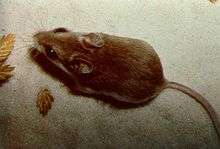Alabama beach mouse
| Alabama beach mouse | |
|---|---|
 | |
| Scientific classification | |
| Kingdom: | Animalia |
| Phylum: | Chordata |
| Class: | Mammalia |
| Order: | Rodentia |
| Superfamily: | Muroidea |
| Family: | Muridae |
| Subfamily: | Neotominae |
| Genus: | Peromyscus |
| Species: | P. polionotus |
| Subspecies: | P. p. ammobates |
| Trinomial name | |
| Peromyscus polionotus ammobates Bowen, 1968 | |
The Alabama beach mouse (Peromyscus polionotus ammobates) is a federally endangered species which lives along the Alabama coast.
The range of the Alabama beach mouse historically included much of the Fort Morgan Peninsula on the Alabama Gulf coast and extends from Ono Island to Fort Morgan.
Coastal residential and commercial development and roadway construction have fragmented and destroyed habitat used by this species. Hurricanes, tropical storms, and dune use by pedestrians have also damaged or destroyed sand dunes and related habitats. Stalking by domestic and wild cats, as well as other animals, plus competition from other rodents have also contributed to Alabama beach mouse declines.

The Alabama beach mouse is one of several subspecies of old field mice living only in coastal sand dune areas. These small light-colored mice burrow and nest in dunes and are primarily active at night. They eat various plant seeds and insects. They prefer sand-covered slopes with patches of sea oats, beach grass, other grasses and herbs.
Interior sand dune ridges provide vital habitat for survival during flooding. Beach mice are an important part of the coastal dune ecosystem. Thriving beach mouse populations indicate a healthy dune system. The mice themselves contribute by collecting and distributing seeds. Uneaten seeds grow into plants which help to stabilize dunes. Beach mice are also an important part of the food chain, providing a food source for dune predators such as the snakes and owls.
The species is endangered and is protected in areas such as the Bon Secour National Wildlife Refuge in Baldwin County, Alabama. In Sierra Club v. Babbitt, environmental organizations halted construction of housing in the Alabama beach mouse's habitat.
References
- ↑ Linzey, A.V. & NatureServe (Hammerson, G.) (2008). "Peromyscus polionotus". IUCN Red List of Threatened Species. Version 2013.2. International Union for Conservation of Nature. Retrieved 17 March 2014. (reference to conservation status of P. p. ssp. ammobates in section Threats)
